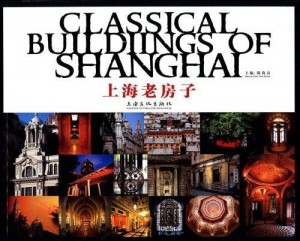
I am always curious about new books related to old Shanghai, and this new one was no exception. Surprisingly, I found it out of my usual circle, in a small shop in Tai Kang Lu. I later checked places like Garden books, but it was not on sale there… or maybe it is already out of stock. Although I was first impressed by the printing quality and the appearance of the book, reading it led to a less enthusiastic judgement.
There are definitely good points with this book, starting with the cover. The mosaic of small pictures is an eye-catcher and printing and paper quality are very high. This definitely makes a good coffee table book. Some pictures are quite recent, with others from the 1990’s. It is actually nice to see how some buildings actually looked before some disastrous renovation (like the red house on Hen Shan Lu), or invasion of advertising (like Sincere Department store on Nanjing Dong Lu). Some of these buildings have been nicely renovated since, so the picture in the book is not as nice as today’s reality. I also have found some of those pictures used previously on various website. This book is clearly not one of original photographs from one photographer, but a collection of already existing pictures. As the book was published in China, it is both in English and in Chinese making it a great tool for show Chinese friend why we love old Shanghai building so much. Moreover, at RMB 100 it is really affordable.
Unfortunately, I also found quite a number of points that make this book miss the 100% score by far. First of all, there is no classification of the buildings, neither by period, location, style or architect firms. Yes the book has nice pictures, but a little bit of order would have helped to make style and period differences easier to understand. Moreover, the level of the description is quite inconsistent in particular in naming the buildings. Sometimes the 1930’s name is used, sometimes today’s name, sometimes… something in the middle. I am also wondering what motivated the choice of including a particular building or not. It is really surprising not to see Bund 18, Kee Club and many of the Art Deco buildings in the French area… nor Broadway Mansions. Anyway, it seems that the authors rarely venture South of Fuxing Lu, or even Huai Hai lu. The other major drawback is the English translation. Some of the parts are well written, but many are difficult to understand due to dubious translation. Furthermore, there are quite lot of omissions or inaccuracies… which also degrades the book overall quality.
At the end, this book is a nice for a coffee table. It is also great to show the beauty of old Shanghai to Chinese friends (with Chinese text) and is affordable… but don’t count on it for an in-depth study of old Shanghai architecture.
Another nice article, Martin. This is why I’m rather picky when selecting my “Old Shanghai Collection”. Most fancy looking (or those so-called HIGH QUALITY) Chinese publications on this topic are rather disappointing; I need not mention anything here as you’ve already covered the points in detailed. Tess’ collection, although simple (well, perhaps the books are intended for casual readers), remains to be my favourite so far.
I lived at “Tai Shan Court” from 1938 till 1953, at building no. 6 apartment no. 58.
There were many Shanghailanders as residents during this period. French, Portuguese, Belgium, Spanish, German, Norweigian, Russian, Japanese, that I can recall.
The Convent of the Sacred Heart School was beyond the compound gate. Just outside the entrance when exiting to the right was a German butcher shop with the freshest meat.
Immediately to the left of the main gate were two ‘mama-papa’ style shops selling a variety of groceries. They had the tastiest jam-filled buns delivered twice daily, and they also sold the very famous “Hazelwood Brand” ice-cream. The Neapolitan consisted of chocolate,vanilla, & strawberry, or chocolate, vanilla, & orange sherbert. They also served ice cream cones with these four varieties. Sarsaparilla, a sweet aerated soft drink in a pear shaped bottle was one of my favorite bottled sodas. They also prepared fresh variety of sandwiches. Ham & cheese was my favorite. Tai Shan Court was located between Cathay Theatre a block or two away to the right of Avenue Joffre and Paris Theatre a block or two to the left. To the right of the main gate, the streets & roads were all named in French, and to the left side the streets & roads were mostly in Chinese. Tramcars ran up and down Avenue Joffre; to the East, all the way to the Bund; and to the right, almost all the way to the Shanghai West Railway Station.
I really would like to get this book. Is there anyone out there that knows how I can order it?
I would really like to buy this book. What was the bookstore on Tai Kang Lu?